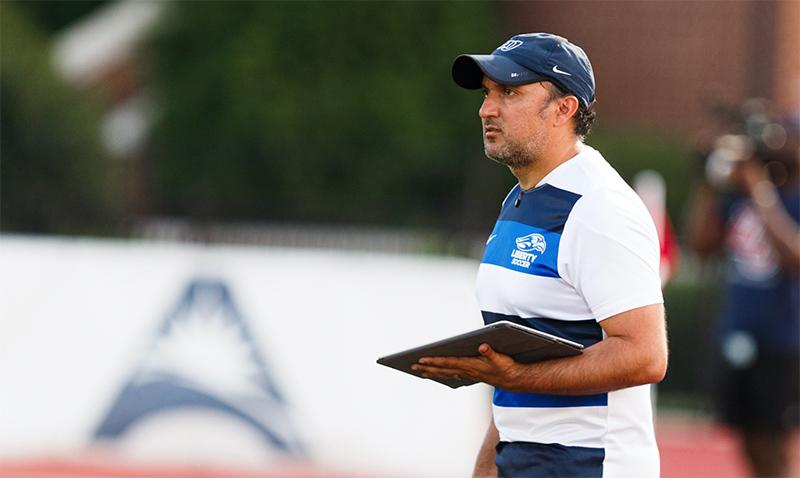
In this series, we’ll be introducing you to some of the coaches and staff taking advantage of the Firstbeat Sports solution to monitor training and recovery. We’ll get their personal view and experiences of how they use Firstbeat in their sport.
Name: A.J. Madero
Sport: Soccer
Role: Director of Performance Analysis
Team: Liberty University Men’s Soccer
Firstbeat Sports technology used: Firstbeat Sports Standard
A.J. has been a member of the Flames’ coaching staff since 2010. As Director of Performance Analysis, he directs personnel in enhancing athletic performance and improving player development. Specifically, he oversees physical development, nutrition, recovery, and conditioning, while developing uses for performance data, research, and innovation.
Why did you choose to use Firstbeat Sports?
We’ve used heart rate monitors and GPS units to track daily workloads for our team since 2011. But as the technology continued to change, we found out what Firstbeat Sports could do in terms of live monitoring and data collection and started to use Firstbeat Sports in 2015. Since then, it has been our number one monitoring tool with reliable data.
What Firstbeat Sports metrics do you use most regularly?
We look at TRIMP scores regularly to break intensity down as a percentage. This percentage is compared to the game loads which allows us to be very specific to our players’ needs. Historical data also means we can properly determine what each session should look like for our players. We also keep track of calories to help maintain in-season weights and so players can see how many calories they will be expending pre- and post-session.

Image: A.J. Madero, Liberty University
You mention using TRIMP scores. Are there specific TRIMP numbers you hope to see in different situations?
Seeing the daily changes in TRIMP scores is useful when to prepare for upcoming game weeks. It is important to be able to see a proper load output leading up to a game and the TRIMP numbers show us a clear picture. We work off of 80%, 60%, and 40% of an individual’s ‘game TRIMP’ score. This gives us some flexibility as each week will be different based on opponent and game location.
What have been the main benefits of using Firstbeat Sports?
It has given us a better understanding of how to properly load and de-load our players. For example, if the acute to chronic workload ratio (ACWR) shifts to a point we’re not comfortable with we can pull intensity back. But the tech also lets us notice when we’re starting to lose out on important training adaptations and can push the players.
We’ve seen a lot of players reach new levels of fitness since using Firstbeat as they became more aware of how to train in an appropriate fitness zone.
What does a typical training week look like for the team?
Because of the tight window of opportunity to train in the college soccer season we have three different training groups with unique schedules – Starters, Non-starters, and Development players. Historical Firstbeat Sports data from these sessions provide our athletes with the estimated loads they will experience.
Our starter group emphasizes recovery and preparation. We have to prepare the non-starters as if they’ll be playing but, if they don’t make the rotation, they have to resume building for the next game. Development players are pushed to seek extra opportunities for development in training.
Can you describe a situation(s) where Firstbeat Sports data has influenced a training, game or coaching decision?
Our offseason training sessions changed dramatically when we learned how much extra load was put on the players when they played in the indoor facility. We learned we could use this training session to work on specific fitness and changed how many games we planned as well as the recovery times. Load monitoring has given us the opportunity to make daily adjustments to increase the players’ ability to train consistently.
In terms of the season itself, a prime example would be when we have two games in three days. We need to properly prepare players for the workload and use historical data to evaluate what an ideal load would look like and adjust and plan the week accordingly.
Another would be using Firstbeat data to inform bringing a player on in a game. This player had been hitting high data numbers over a two-week window, so we took an opportunity to de-load them during this particular week. The plan was a success as they instantly changed the game and provided the spark to help our team with the game. In the long run, this de-load week helped prepare the player for the back stretch of the season as we knew he’d be playing 75-80 minutes a game.
How do you prioritize recovery during a busy season?
We deploy a variety of recovery strategies to promote healing as quickly as possible. We try to stick to a similar schedule and plan so players can remain in a similar routine whenever possible. Using Firstbeat’s Quick Recovery Test scores allows us to make individual adjustments leading up to the game – e.g. adjusting lifting sessions based on workloads. We learned very quickly we could do a 20 min lift to create a recovery response immediately and this allowed us to get up to three lifts in per week.
How do you communicate and feedback the data?
Firstbeat Sports’ simple dashboard provides a fast and effective way to gauge our players. Our performance team also uses the data to open discussions with individual players. They like to know if they are improving on their HRV scores and if they are hitting the individual numbers to maintain or improve performance. Collaboration means our nutrition department get extra individual information and our strength coach follows these numbers to adjust weekly lifts.
Do you use the automated reports? If so, how and for what purpose?
We have an automated report sent out at the end of every training session which provides the performance team quick information that helps us make better decisions for upcoming sessions.
Looking at the weekly training loads tells a story and lets you to make a decision on how the next five days will play out. Some players excel at a high training load while other players would start to break down if they trained consistently at that level. Seeing this information is important to determine how to proceed in terms of maintaining high load or focusing on recovery.
Has Firstbeat improved or influenced performance staff?
Using Firstbeat Sports has created a culture of performing to a standard. Solo Tat (Head Strength Coach) and Dan Preusser Head Athletic Trainer) have been extremely influential in this movement. Five years ago, when we started to work with Firstbeat we all saw benefits from different angles. But we now encourage open communication and collaboration. This open dialogue, informed by the data, give us a fresh perspective.
As part of the performance staff our goal is to provide the athlete with every opportunity to be successful and Firstbeat Sports provides this experience and more when it comes to player development.
If you liked this article, you should subscribe to our newsletter.
Give your team the Firstbeat Sports competitive advantage.
Contact us for more information or get a quote.
You might also be interested in

University of South Carolina Soccer Programs Among the Best in Training and Recovery Monitoring
A growing number of collegiate athletes are benefiting from technology as they pursue their performance dreams. With the NCAA Women’s Soccer and Field Hockey tournaments getting underway this week, eight…

How Arsenal Manage Player Data to Achieve Peak Performance
Technology in sport is increasing at a rapid rate. Arsenal’s Tom Allen reveals how to pinpoint the key data and monitor players effectively during the season.


